Virtual VOC: 10 Advantages & 7 Tips for Success

First, let’s be clear that in-person VOC has major advantages over virtual VOC (voice of customer). Want to watch for body language and non-verbal cues? Better have an in-person meeting. Want to build much stronger customer relationships? Best to get on a plane. Want a tour of the customer’s facility? Don’t ask your customer to strap on a GoPro camera.
But there are advantages of virtual VOC over in-person VOC. We won’t argue virtual VOC is better—far from it. But we don’t want you dismissing virtual voice-of-customer or overlooking ways to make it incredibly powerful. The advantages of in-person VOC are self-evident, so we’ll focus on less obvious benefits of virtual VOC. You may choose 100% in-person, 100% virtual, or a blend of the two. You get to choose.
What does virtual VOC look like? Our focus here is gaining market insights for B2B innovation through qualitative and quantitative interviews. Your moderator, note-taker and observer could sit in your conference room, while several customer contacts sit in their conference room. Or just your sales rep could meet in-person while the rest of your team is at the home office. Or if circumstances dictate, all participants could join the interview from their home offices.
If circumstances dictate, all participants could join the interview from their home offices.
All parties connect via a web-conference service, e.g. Skype, Zoom or Webex. Your virtual VOC should let customers watch their responses being recorded. New Product Blueprinting practitioners use highly-visual sticky notes and slider rating bars for Discovery and Preference interviews, respectively (see illustration).
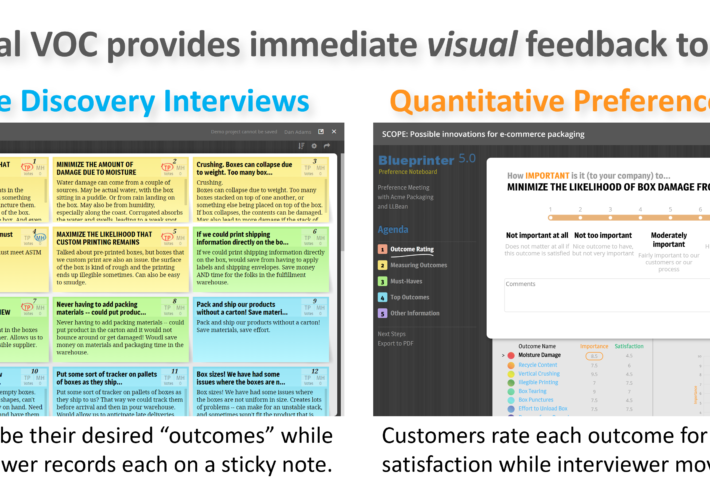
Advantage 1: Lower cost. We just had to begin with the obvious, didn’t we? Imagine you send 2-3 interviewers out on 6-10 qualitative and 6-10 quantitative interviews. You could easily spend $50,000 on travel expenses. And you’ve probably consumed 2-3 person-months of employee time, with at least 80% wasted in rental cars, security lines and cramped airplane seats. These travel expenses and non-productive personnel time go away with virtual VOC.
Advantage 2: Dispersed customer contacts: Virtual VOC is ideal if your customer’s R&D staff is in Houston, its marketing in Chicago, and so on. Or if they’re all working from home and your team is as well. Geography no longer matters. This is great for qualitative Discovery interviews, because you want to interview multiple customer contacts simultaneously so they can build off each other’s ideas. Just like brainstorming.
For quantitative Preference interviews, it’s even more important to engage all decision-influencers at the same time. Why? Imagine the operations manager rates the importance of abrasion resistance at “3” and the marketing person gives it a “9.” If you gathered their results individually, you’d have to average their responses at “6”… a terrible idea. But in a virtual session with all present, you can let them debate. You finally resolve their department-specific viewpoints with this simple question: “From the perspective of your entire company, how important is abrasion resistance?”
Advantage 3: Viewable probing tips: The key to great VOC is great probing. Practitioners of New Product Blueprinting learn the “What and Why” method of probing. The moderator asks “What” questions, such as “When does this happen?” and “Can you describe this?” Then she asks “Why” questions, like “How does this impact you?” Before moving to the next customer outcome (“What other problems are you seeing?”), the moderator asks, “Anything else we should know before we move on?” (See illustration.)

Here’s an advantage of virtual VOC over in-person VOC: You can set these tips in front of you during the interview and constantly refer to them. Yes, you’re able to do this in a face-to-face interview, but it’s much smoother in a web-conference because customers can’t see you checking your notes.
Advantage 4: Training for colleagues: What if you want to train additional employees in B2B VOC? Wouldn’t it be helpful if they could observe real VOC interviews… without travel costs… without taking much time… without disrupting the interview dynamics? Virtual VOC comes through again. Introduce them at the beginning of the interview—no one should ever eavesdrop—and then let them observe the interview. They can easily do this in a conference room with the rest of the interview team or from their home office.
What’s the ROI for “Voice of the Customer”? Read this article to learn more.
Advantage 5: Probing suggestions: If your remote interview team is meeting in a home-office conference room together, make sure it has a whiteboard or flipchart. If possible, have two observers supporting the moderator and note-taker. As the observers think of probing questions the moderator missed, they write them on the whiteboard, making sure to also record the number of the sticky note. Then your brilliant-sounding moderator can say to the customer, “I had another question about something you said on note number 2… damage due to moisture.”
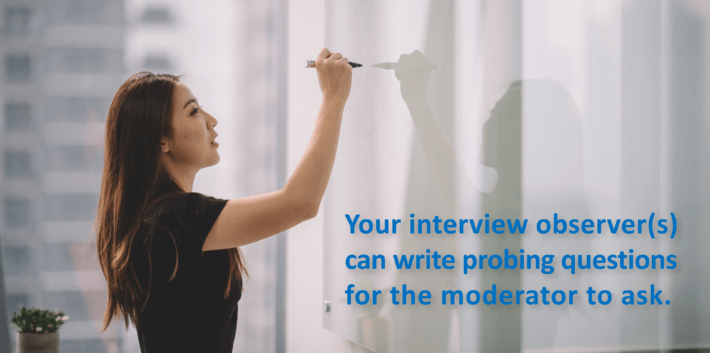
Advantage 6: Assistance for note-taker: We’ve noticed something peculiar about in-person interviewing: Customers sometimes forget about the poor note-taker. Because they’re so engaged in the discussion, they may fail to notice that the note-taker is falling behind. These dynamics change with virtual VOC. Since the only thing customers can watch is the web-conference screen, they immediately notice any lagging note-taking. We find customers are more helpful in slowing their pace, repeating points, and suggesting text changes.
Advantage 7: Rapid debriefing: After an in-person interview, the team should go to a nearby coffee shop or airport lounge and debrief: Picture the team gathered at Starbucks with the observer recommending additions and changes as the note-taker makes them in the appropriate sticky notes. The Ebbinghaus Forgetting Curve suggests we forget half of what we’ve learned in the first 24 hours. With virtual VOC, the debriefing can begin immediately after the interview. No hunting for a place to speak openly, setting up the laptop again, worrying about catching flights, etc.
Advantage 8: Easier scheduling: Sometimes the hardest part of B2B VOC is scheduling the interview. The issue usually boils down to availability and reluctance, and virtual VOC helps with both. The availability of your team can be dicey if all three of you need the same open travel day that the customer is available. But it’s easier finding a time when you’re all available for a 1-to-2 hour virtual interview.
Sometimes the hardest part of B2B VOC is scheduling the interview.
What about customer “reluctance”? Would you rather have a traveling salesman come to your home or call you on the phone? OK, perhaps a bad analogy, but you get the idea. Some customers will feel more comfortable giving up an hour or even two, if they know they can say at the end of the allotted time, “Well, I need to go to my next meeting now.”
Advantage 9: Low-impact cancellations: Face it, you’ll likely have some cancelled customer interviews. Your main contact got sick, they just had a business emergency, their CEO called an all-hands meeting, their conference room was taken over by a VP… or they simply messed up their calendars. With virtual VOC, you don’t need to limp back to the airport empty-handed at the end of a wasted day. You simply reschedule.
Advantage 10: Greater project speed: We saved our favorite for last. If your new product eventually has annual sales of $5 million with average profits, can you guess the net present value of accelerating the launch by one month? $80,000. That’s $4,000 NPV per business day. Speed matters! Virtual VOC lets you move faster with more productive scheduling, and the ability to schedule two or more interviews per day. Converting many of your in-person interviews to virtual VOC can easily trim a month or two off your timeline.
That’s $4,000 NPV per business day. Speed matters!
One more suggestion: As you finish up each Discovery interview, ask the customer for a good date and time for the Preference interview. Get it on the calendar now, and you’ll accelerate your timeline and save the hassle of setting up Preference interviews later. Use this tip with both in-person and virtual VOC and you’ll be pleased at how rapidly you finish your interviews.
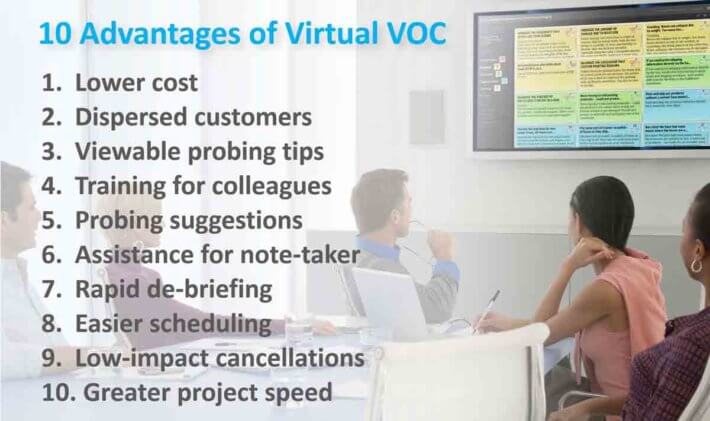
So yes, in-person voice-of-customer remains the gold standard, but virtual VOC has many advantages you can enjoy. But when should you use virtual VOC? And how do you employ it for maximum impact and benefits? Let’s explore seven tips.
Tip 1: Choose wisely. We’ve seen projects where interviews were done a) only in-person, b) only virtually, and c) with a mix of the two. You need to consider many factors to determine the right approach for your project. All else being equal, here are the factors that lean toward virtual VOC:
- Team experience: Virtual VOC is easier if your team has already mastered the dynamics of in-person interviews. (You can gain experience by practicing on your own sales reps or distributors.)
- Customer relationship: Virtual VOC works especially well when you’ve already established a relationship with a friendly customer.
- No need for tour: Consider virtual VOC after you’ve completed enough customer tours with earlier in-person interview sessions.
- Interview type: Virtual VOC works well for both Discovery and Preference interviews, but is especially productive for the latter.
- Scheduling: If you’re having a hard time coordinating calendars, consider scheduling a virtual interview.
- Travel costs: Virtual VOC eliminates your travel costs, especially helpful in difficult economies or when international interviews are needed.
- Interviewing progress: Many teams conduct their initial interviews in-person, and then move to virtual VOC. The latter is most helpful for Preference interviews when you want more 1-to-10 outcome ratings to boost your statistical confidence.
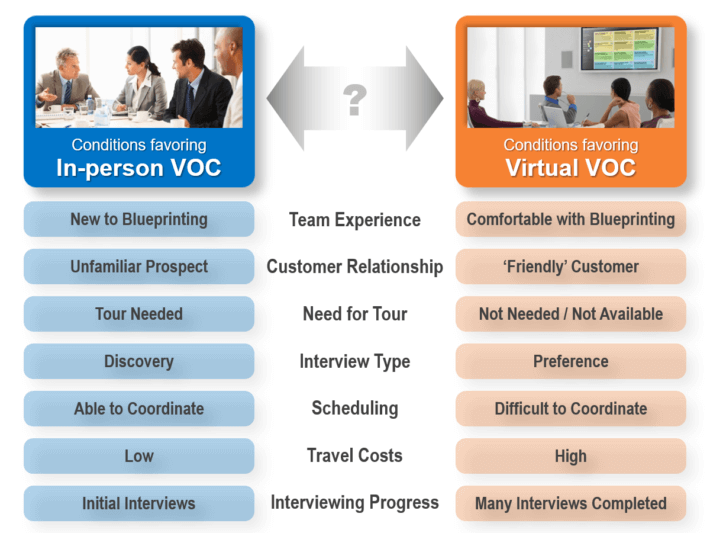
Tip 2: Build your team’s skills. Practice interviewing as a team in a “step-wise” fashion, beginning with “safe” audiences:
- Industry Experts: If you pay to interview a GLG, AlphaSights or similar industry expert, take this opportunity to improve your skills. Forget the phone-only approach and conduct a virtual web-conference interview. Ask the expert to answer your questions as customers in the target market would likely reply.
- Sales colleagues: Set up a web-conference and ask them to respond “as the customer would.” Beside great practice, you’ll get your sales team more comfortable with these interviews, so they’ll be more effective in requesting them.
- Internal departments: Do you have others in your company with experience in this area, perhaps based on their prior work at another company? These could be helpful interview candidates.
- Distributors: If you use distributors, interview them before the “real” customers using your product. It will be good practice for you, let’s you understand how much insight they have, and turns your distributors into more effective partners.
- Smaller, safer customers: If you have smaller customers, start your interviews with them. Also, consider interviewing “friendly” customers who will overlook your lack of “smoothness” until you get comfortable with this type of interviewing.
- Larger, high-stakes customers: By the time you “build up” to these customers with prior practice, you and your team-mates will be one, highly-polished, impressive interviewing team!
Tip 3: Prepare your customer. If you’re looking for great virtual VOC, you’ll need to carefully prepare your interviewees:
- Work hard to get several customer contacts joining each interview: You’ll get more valuable information this way, and raise the overall energy level.
- Make sure all customer attendees—not just your main contact—receive a copy of the meeting agenda.
- Don’t call this an “interview” (which can have a bad connotation). Instead, call it a Discovery or Preference “meeting” or “session.”
- Provide the WIIFM (“what’s in it for me”) to customers. For instance, tell them you could be a source of open innovation for them. But to do this, you first must understand their needs.
- Ask your main contact to join the meeting 10-15 minutes early in their conference room, so you can get the web-conference working and do a sound check.
Tip 4: Make this enjoyable for customers. With a little effort, your virtual VOC will engage and energize your customers. Here’s how:
- Use your webcams so they can see your smiling faces… especially at the beginning of the session. At a minimum, display photos of yourselves.
- At the onset, go around the room with introductions. Start with your team members and keep it light.
- Why not order some food to be delivered from a local restaurant, such as Panera? (Check with your main contact first.)
- Use lots of visual cues during the meeting. If you’re using Discovery sticky notes, refer to the note number so all can follow along. Or if you want to draw their attention to some text, be sure to highlight it.
Tip 5: Probe like a pro. Getting the right customer contacts into your interview is the most important part of strong VOC. After that, top-flight probing separates great VOC from mediocre VOC. Go for “great” with these tips:
- Put your probing tips in front of you during virtual VOC. As discussed in Advantage #3, you can continue referring to your “what and why” probing questions throughout the interview.
- If your interview team is meeting in one conference room, have your observer(s) write good probing questions on a whiteboard, as suggested in Advantage #5.
- Invite VOC “trainees” to your virtual VOC so they get first-hand experience. By the time they start conducting their own interviews, they’ll be past the novice stage. (See Advantage #4.)
Top-flight probing separates great VOC from mediocre VOC.
Tip 6: Consider sending a local colleague. Do you have a sales rep in the customer’s geographic area that could represent your company? They can be helpful in several ways:
- Have your sale professional arrive early and help with meeting setup. Then everything is ready to go when the first customer walks in the conference room.
- Having your colleague in the customer conference room for greetings and introductions is a great ice-breaker.
- Your local person can be your primary interview “observer.” They should watch body language, monitor signs of impatience, notice if one person isn’t getting a chance to speak, etc.
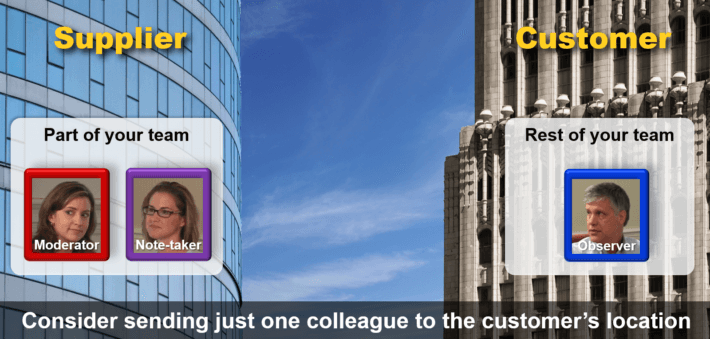
Tip 7: Ensure strong follow-up. This is true for in-person as well as virtual VOC… but it bears mentioning. Be sure to follow-up after your interview. The worst possible outcome of a B2B interview is your customer saying this: “Yes, that company did a nice interview… but then we never heard from them again.” Consider these simple approaches:
- Ask the customer how they’d like to be updated… and do it
- Make a phone call or send an e-mail to say thank you
- Send a PDF of the interview notes & ask them for updates
- Call them to ask for help in clarifying some points
- Share summarized industry results of your interviews
- Call or e-mail to indicate that your project is still active
- Have your sales rep provide them with periodic updates
- Share your new product prototypes with the customer
Getting started with virtual VOC…
It’s not hard to turn your company into a virtual VOC powerhouse. The first step is mastering the fundamentals of B2B-optimized interviewing—nearly all of which apply to both in-person and virtual voice-of-customer. Here are some steps you can take to get started:
- Check out this short video to see how Discovery and Preference interviews are done in-person. You’ll notice how easy the “jump” to virtual VOC would be.
- Download this e-book, Reinventing VOC for B2B, which is loaded with tips for B2B-optimized VOC.
- Join us at one of our open New Product Blueprinting workshops. Details are at blueprintingworkshop.com
- Contact us for a consultation. Don’t be surprised if we suggest a short virtual web-conference.
We know that better VOC leads to better customer insight… which leads to better innovation… which leads to better growth. Whether you get on an airplane or work from home… this is our wish for you.
View video of a Voice-of-Customer simulation using New Product Blueprinting
Comments